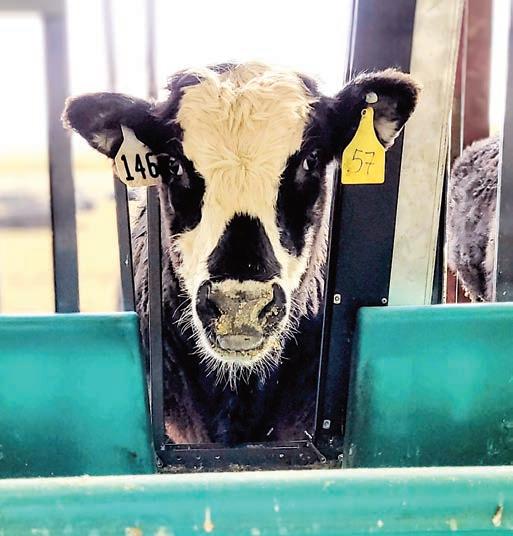
7 minute read
Life/Art Ensemble takes dance into the world
Coming Attractions
When many people think of starting a dance organization, they probably conjure up images of children or teenagers awkwardly guring out how to get their feet to do what their minds want them to. But Life/Art Dance Ensemble got its start in 2009 with a di erent audience in mind.
said. “Our primary goal in serving older adults is to improve their quality of life, social and mental health, mood, and overall sense of well-being.” Find more information about Life/ Art and its work at www.lifeartdance. org/.
Explore all the arts at Denver Fringe Festival of dollars of equipment that allow scientists to track everything that goes into each cow, along with some of what comes out.
Specialized feed bins use radiofrequency identi cation (RFID) technology to track every ounce of corn consumed on a per cow basis. Another piece of equipment called the GreenFeed machine analyzes the gases cattle exhale. It’s a bit like a high-tech gumball machine, dispensing tasty cow treats — alfalfa pellets — on a schedule, and at the beckoning of a smartphone app operated by researchers.
On a chilly afternoon in March, Colorado State University Animal Sciences Professor Sara Place demonstrated the technology, tapping a button on her phone. A highpitched electronic chime sounded and the alfalfa pellets dropped into an opening at cow level, catching the attention of a big-eyed angus

SEE CATTLE, P17
“I am a registered dietitian nutritionist and my very rst job out of college was with Volunteers of America, Colorado Branch. I co-ran the Healthy Aging program there and we would bring nutrition, exercise, and fall prevention classes to low-income residences for older adults,” explained Jessica Riggs, artistic director and founder of Life/ Art. “I also learned that entertainment budgets at these residences weren’t high and that there was a lack of quality entertainment available, particularly for those who had impaired mobility or couldn’t a ord tickets to a show.”
And from that experience came the idea of bringing dance directly to older adults.
In the 14 years since its founding, the organization has expanded to o er contemporary dance performances all over the metro area.
“We work with live music and different creative concepts to take dance out of the theater and move it into the world,” Riggs said. “We’re trying to expose people to what dance can be and collaborate with as many di erent groups as we can.” e metro dance scene can often be very siloed, Riggs said, so collaboration has become a crucial feature of nearly every project the organization engages with. Some examples include the annual Life In Motion: A Colorado Dance Film Festival, which showcases Colorado dance lm artists, and the Convergence event, which is a costsharing show featuring all kinds of local dance organizations, like Rocky Mountain Rhythm and Front Range Contemporary Ballet Company.
While summer is a bit of a quiet time for Life/Art when it comes to public performances, there’s always something to work on. e organization is currently preparing for this year’s Convergence performance and a dance haunted house, also slated for the fall.
But, in the meantime, the work with older adults never stops. at is due, at least in part, to the 2021 expansion of their program to feature inclusive dance classes taught in the DanceAbility method. According to Riggs, this allows the residents to be able to dance themselves, regardless of any physical limitation they might have.
“ ere are many physical, mental, and emotional bene ts to dance,” she
You never know what you’re going to see at the Denver Fringe Festival, but that’s what makes it such an adventure. e fourth annual event, which runs at 12 venues all over RiNo and Five Points from ursday, June 8 through Sunday, June 11, brings more than 150 performances to audiences thirsting for something original.
According to provided information, the festival will feature “eight original plays, six immersive experiences, a two-day KidsFringe with free shows for families, street performances” and more. With the aim of promoting access to the arts and showcasing diverse artistic voices, you really can’t go wrong. All the details can be found at https://denverfringe.org/.
Films for Foodies kicks o with ‘Chef’ e clever folks at Denver Film, Dazzle and Denver Arts & Venues have gone and added to food, music and a night under the stars to an already great activity — a night at the movies. ey’re kicking o their Films for Foodies series on Tuesday, June 13 with a screening of Jon Favreau’s “Chef” at the Galleria @ Denver Performing Arts Complex, 1400 Curtis St. in Denver. On the music side, Raul Murciano’s Colorado Mambo Orchestra will be performing, and Fritay Haitian Cuisine, Areyto Puerto Rican Food and HipPOPs food trucks will be on hand serving food. Get all the information for this delicious cinematic evening at www. artscomplex.com/events/summer-atthe-arts-complex.
Clarke’s Concert of the Week — Cub Sport at the Marquis who moseyed up for a bite to eat.
It is di cult to put a nger on the kind of music Australia’s Cub Sport makes. ere are elements of electronic-based groups like Cut Copy, to be sure, as well as alternative-leaning pop like e 1975 and Walk the Moon. But really, their style is all their own. All I know is, their fth album, “Jesus at the Gay Bar,” is one of the year’s best thus far. It’s fun and funky and gets you moving but makes you a bit sad, too. It has something for everyone.
In support of the album, the Cub Sport will be performing at the Marquis, 2009 Larimer St., Denver, at 8 p.m. on Wednesday, June 14. ey’ll be joined for the show by opener crêpe girl. Get tickets at www.livenation.com.
Clarke Reader’s column on culture appears on a weekly basis. He can be reached at Clarke.Reader@hotmail.com.
“He’s got his head stuck in the machine and he’s chowing down a little bit of a snack,” Place explained.
Despite common misconceptions about the perils of bovine atulence, most methane comes out of the cow’s front end in the form of enteric emissions. at means each time an cow gets a snack from the GreenFeed machine, Place has an opportunity to get information.
“ e air gets pulled from around the animal’s face, and whatever they’re respiring out goes directly into the machine,” Place said. “We can get real time methane emissions data from that.” e animal agriculture industry, which includes all operations that raise animals for meat or dairy, produces more methane than any other human activity in the U.S.
Methane is a powerful greenhouse gas that has a warming power 80 times more potent than carbon dioxide in the rst 20 years of emission.
Climate experts say we’re running out of time to prevent climate catastrophe. To avoid the worst of it, experts say it is imperative to cut greenhouse gas emissions dramatically before 2030. Environmental groups have ambitious goals to reduce agricultural methane emissions by 30% globally by the year 2030. But when it comes to emissions from the livestock sector, the science is still just emerging, and it’s not yet clear if the cuts will come in time—or how.
Place hopes to change that with her work in the research pens.
“We want to nd solutions that can help mitigate those emissions to cut the climate impact of beef,” Place said.
A tricky proposition
Reducing the climate footprint of beef is a complex problem. According to Kim Stackhouse Lawson, director of CSU’s AgNext program, producing methane is just part of being a cow.
“ ey’re biologically supposed to make methane,” she said.
e gases are the byproduct of a complex fermentation process that happens inside a cow’s largest stomach, called the rumen. Changing that equation involves tinkering with the complex microbiological ecosystem inside a living animal’s stomach, which means there’s still a lot we don’t know.
For instance, there is still no experimental data on baseline emissions from the livestock industry.
“ e data is not granular enough,” Stackhouse Lawson said.
e best understanding of the cattle emissions picture comes from the Environmental Protection Agency’s greenhouse gas emissions inventory, which derives its data from a model that uses emissions factors - essentially multipliers from a chart, so the data is based on equations rather than direct measurements from the animals themselves.
Stackhouse Lawson said the inventory does a decent job of estimating livestock emissions at the scale of the entire U.S. But for individual operations trying to account for the carbon footprint of their own herds, those numbers are too generalized to tell the full story.
“ ere’s too much variability between animals, there’s too much variability within region,” she said.
Stackhouse Lawson’s team is only now doing the work of developing more precise numbers. She cited surprising initial data from CSU’s research pens that shows the quantities of methane cows produce can vary wildly from animal to animal, suggesting an entirely new frontier for the research.
“Is there a genetic component?” She wondered. “Would we select animals that have lower methane?” e CSU team is also looking at other variables like feed additives that can cut emissions outright.
John Tauzel, senior director for global agriculture methane with the Environmental Defense Fund, explained successful additives “will change the biome of the cow’s stomach to reduce the amount of methanogens—the organisms that create the methane.” It’s a solution he went on to describe as “really, really complex,” because of the complicated structure of the livestock industry and the biological intricacies of cattle microbiomes. at complex problem remains only partially-solved, in part due to lack of funding for the research. Tauzel pointed out that only 2% of federal funds that support research and development for climate adaptation and mitigation in agriculture go toward reducing enteric emissions. at investment is starting to come. Just last week, the team at AgNext announced it had received a $1 million Conservation Innovation grant from the US Department of Agriculture. e money will support continued research into emissions on the feedlot. It will also allow the researchers to expand their inquiry into cattle emissions to look at cows grazing in a pasture setting. Stackhouse Lawson hopes more funding could be part of the next Farm Bill currently being negotiated in congress. is KUNC story via e Associated Press’ Storyshare, of which Colorado Community Media is a member.
“We need more investment in that space if we’re going to meet the reductions in timeframes that we need,” Tauzel said.
Until more federal dollars start owing, the research being done on cattle emissions is dependent on industry to ll the funding gap.









